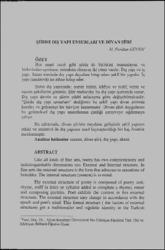Şiirde Dış Yapı Unsurları ve Divan Şiiri
Abstract
Her sanat eseri gibi şiirin de birbirini tamamlayan ve birbirinden ayrılması mümkün olmayan iki yönü vardır: Dış yapı ve iç yapı. Sanat eserinde dış yapı duyulara hitap eden şeklî bir yapıdır. İç yapı (muhtevâ) ise zihne hitap eder.
Şiirin dış yapısında; nazım birimi, kâfiye ve redif, vezin ve nazım şekillerini görürüz. Şâir muhtevâyı bu dış yapı içerisinde sunar. Dış yapı devrin ve şâirin edebî anlayışına göre değişebilmektedir. "Şiirde dış yapı unsurları" dediğimiz bu şeklî yapı divan şiirinde kuralcı ve gelenekçi bir hüviyet kazanmıştır. Divan şâiri duygularını bu geleneksel dış yapı unsurlarının çizdiği çerçeveye sığdırmaya çalışır.
Bu çalışmada, divan şiirinin meydana gelişinde şeklî yapının etkisi ve muhtevâ ile dış yapının nasıl kaynaştırıldığı bir kaç örnekle incelenmiştir. Like ali kinds of fine arts, poetry has two complementary and indistinguishable dimensions too: Extemal and Intemal structure. In fine arts the extemal structure is the form that adresses to sensations of beholder. The intemal structure (content) is to mind.
The extemal structure of poetry is composed of poetry unit, rhyme, redîf (a letter or syllable added to complate a rhyme), meter and composing poetries. Poet exhibits the content in this extemal structure. The extemal structure may change in accordance with the epoch and poet's mind. This formal structure ( the factors of extemal structure) got a traditionalist and reğulatie identity in the Turkish Classical Poetry. And the classical Turkish poet tries to settle his emotions in this form.
In this study, the effect of formal structure in the formation of Classical Turkish Poetry and how the content and form interrelated are supplied in same examples.
Source
Sosyal Bilimler DergisiVolume
2Issue
1Collections
- Cilt 2 : Sayı 1 [15]



















